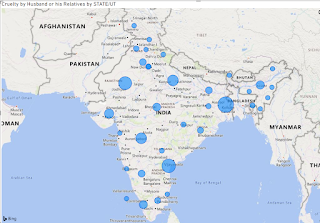Crimes against women
Crimes against Women (2001-2014)
A case-study
We have all heard
blood-boiling stories of rapes, human trafficking, abusive assaults against
women but often all we can do is sympathize towards the victim and eventually, the story gathers dust at storage rooms of police or media archives.
This is an attempt to
shed some light on these crimes.
At 3,44,124, WEST BENGAL has the highest Cruelty by Husband or
his Relatives accounting for 15.40%
of the cases.
It is a
linear graph translating to an increase in cases with time.
After 70+
years of Independence and amelioration of human rights and science, Dowry
Deaths are still a common sight in India, which is not only shameful but also
hideous and pathetic.
At 57,256, UTTAR PRADESH had the highest Dowry Deaths accounting for 26.57% of Dowry Deaths.
A general
uptrend is abysmal. 2003 had 12,416 cases (least) and 2011 had 17,236 cases
(maximum).
Rape is one of the
most shameless acts of humans. It shows a lack of respect and narcissism at the
very heart of a person that they don’t regard for the consent of another
person.
At 90,996, MADHYA PRADESH had the highest Rape cases and
accounted for 14.70% of Rape.
As evident, Cruelty
against Women has had a maximum number of cases since 2001 and keeps on growing
at an astonishing and unhealthy rate.
This particular
instance happens in 2005 onwards when the curve starts to gain momentum. In
2005 Government of India had brought into effect the Protection of Women from
Domestic Violence Act.
But this was a
positive move from the government and one would naturally ponder upon the
ever-increasing rate at which the crime was registered.
PWDVA gave women the
voice and support they needed to speak against the injustice that they were
silently tolerating.
This was a positive
change reflecting the changing mindset. Women of India were always instructed
that family is the most important thing in their life, but when that family became
the cause of her sadness, she had no choice but to suffer silently.
With PWDV Act, women
had the backing of the law. They spoke for their freedom and respect and more
cases were registered.
This forces us to
think about the number of crimes that were never registered at all, women are still
subjected to cruelty and prioritize the husband/family before their own
wellbeing.
A similar trend is
spotted in 2012.
One horrible and
extremely blood raging crime took place in December 2012, Delhi. The Nirbhaya
Rape Case.
In 2011-2012 India was
the 4th largest economy. Scientific and Technological Advancements
were at an all-time high but this one crime proved it was all in vain if we
can’t have a safe place for women, for our very own citizens. The law is
hollow.
In Early 2013, the Government rolled the Nirbhaya Act into effect with laws related to sexual
offences.
The graph then follows
an almost vertical trend until the end which might be the same effect as
discussed above with the PWDV Act. Women who dared to speak before now came
forth. It had to be done because the Nirbhaya case was so frightening and
barbaric that one could not even imagine what she had gone through.
It’s not over yet.
Even in 2021 as I write this, there’s always news of women subjected to grave
iniquities.
Education and
inculcation of respect for all genders are key when it comes to a safe and utopian
environment. Tightening security and surveillance in the states with the highest
number of crimes should slow down the crimes as well.
Source: https://www.kaggle.com/greeshmagirish/crime-against-women-20012014-india
Written by: Yash Chauhan










Comments
Post a Comment